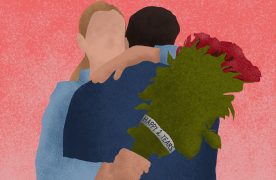Ride hailing services like Uber and Lyft have become a way for people to more conveniently get to their destinations — and one that usually comes with a cost.
These app-based services mostly target young people, including college students and young professionals, who use them as ways to get to work and class every day. In Boston, the inefficiency and unpredictability of public transportation forces many to favor apps like Uber and Lyft. This, combined with unreliable New England weather conditions (especially in the winter) lead many to call an Uber rather than using questionable transit options that could be slow, far from their destinations, or both.
Of course, Uber and Lyft also target a more wealthy population who are more capable of affording a ride that might be $10 or $20. However, rides are not always this expensive, and many people who find the T more troublesome use a less expensive UberPool to get to their destination. The T is a $2.25 endeavor itself, so many people opt to splurge an extra dollar or two for a more convenient, better experience in a car than what they might find on the T.
However, these ride-sharing vehicles take up space on the streets, contributing to the heavy traffic congestion around the city, particularly during peak commuting hours. Perhaps, the real cost of Uber and Lyft is the impact they have on Boston-area traffic, rather than just on the individual people who endure their sometimes heftier prices.
According to a survey conducted by the Metropolitan Area Planning Council, 42 percent of Boston customers using ride-hailing services reported that if these apps weren’t available, they would opt for public transportation. This calls for the city’s transportation authorities to do some rethinking about public transit options. Officials should consider ways to improve efficiency in order for residents to make better use of the T in order to avoid adding to the city’s traffic problems. Implementing educational initiatives, such as a Traffic Control Course for planners and transit personnel, could help develop smarter strategies to ease congestion and promote safer, more efficient commuting options.
First and foremost, the MAPC report is a sign that the public transit needs to be improved. In Boston, the T does not cover all of the city’s neighborhoods. That’s right — the T doesn’t reach some areas in Boston at all. And some places that the T does reach, it doesn’t reach very efficiently. For example, trying to get to Cambridge for many Boston University students proves to be a time-consuming, inefficient experience. Getting to Harvard Square from most places in East Campus, a mere 2.5 mile distance, can be a 40 minute trip on the T.
Not having access to adequate and effective public transportation is unacceptable. And while the option of walking or forsaking a trip all together may conserve energy, we can surely envision a world where cars and trains become more environmentally-friendly and can still be used as a transportation option. Sure, Boston has its complexities when it comes to roads and transportation, mainly from its old city planning model, but it can certainly do better.
Transportation authorities should consider charging ride-hailing companies more for using the city’s roads. After all, Uber and Lyft are companies from the private sector making money by using public roads, serviced by the government. Therefore, they should contribute towards the state’s transportation fund. An additional 10 or 20 cent charge to customers would probably not deter them from using the service. If they’re going to contribute to the city’s traffic, then they should at the very least pay the price and support public transportation.
Unfortunately, many of the city’s traffic problems require an entire overhaul of the system. Some aspects simply cannot be changed. Construction projects require time and energy at the cost of inconveniencing many people. Therefore, much of the infrastructure is set in stone. The only thing we can hope for is increased efficiency. And more importantly, even if these improvements don’t alleviate traffic, then certainly it should help the many residents who rely on the T for their daily commute to work. Improving the efficiency of public transit in Boston can go a long way for the city and reducing the severity of traffic.













